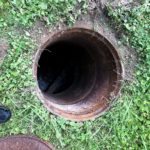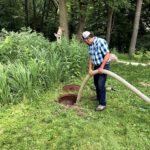by Winding Pathways | Nov 28, 2019 | (Sub)Urban Homesteading, Home Improvements
Winding Pathways appreciates and enjoys quality tools. So, we have an affiliate relationship with Acme Tools. We do this because of their quality tools, supplies, and outstanding customer service.
Acme Tools carries multiple brands. All are of high quality. They are reliable, safe, and user-friendly. People come in different sizes. Customers can find different sized tools comfortable for anyone of any size to use.
After years of using bargain tools that frequently broke or failed, Winding Pathways went to Acme Tools and purchased various Milwaukee Brand tools. They cost a little more upfront. In the long run, this purchasing philosophy has saved us money and reduced frustration.
Quality tools sold by Acme Tools last a long time and, unlike cheaper counterparts, can be repaired.
Here are some Milwaukee items we have purchased at Acme Tools and enjoy using.
Cordless Drills
Cordless Multi-Tool
Cordless Saws
Flashlights
Apparel – Jackets, Gloves, and more
Radio
Hand Tools – Screwdrivers, hammers, measurers, squares, and more
Vacuum Cleaners
by Winding Pathways | Sep 26, 2019 | (Sub)Urban Homesteading, Energy Efficiency, Home Improvements
Note: Winding Pathways received no discount or special consideration for selecting DeNeve Construction and writing this blog about class 4 rubber shingles. This reflects our personal experience and research.
Most of our Winding Pathways blogs are about managing a yard for beauty, health, and to attract fascinating wildlife. Sometimes we share house tips, especially about energy savings and photovoltaics.
We just learned something new. Our roof’s shingles had been put in about 20 years ago. They were supposed to last longer but were stiff, beginning to curl, and some nails were poking out above the shingles. It was time for a new roof.

The crew were fast, efficient and friendly.
We received three bids from local roofers and hired DeNeve Construction to do the work. Owner Rick DeNeve met us and said, “I suggest you use Class 4 shingles. They are a little more expensive but resist hail and wind and last longer than normal ones. Give your insurance company a call, and you may get a discount if you use Class 4s.”
We did and learned that we’d receive a whopping 26% reduction in home insurance premium cost by using Class 4 instead of less expensive and durable shingles. That’s a savings of about $260 a year in insurance cost.
“Most shingles have a fiberglass base layer. Every spot hit by a large hailstone suffers damage, and this greatly shortens the life of the roof. Class 4 shingles have a rubber base, and hailstones bounce off without damage,” continued DeNeve.
Life Cycle Cost

Men putting on shingles
Whenever we buy anything for the house, we consider life cycle cost. Simply put, that is the cost of the item based on its average annual cost determined by its expected life. Some examples are the roof, paint, refrigerator, and just about everything else people buy.
In this case, cheap shingles would have saved us about $2,000 on our rather large roof but we could expect to change them within 20 years. Class 4 shingles are likely to last at least 30 years. The upfront cost is a little higher but the long-term cost is lower.
That seems to be a common situation. Anything that’s durable is likely to cost more to buy than a cheap counterpart, but in the long run, it is less expensive and saves money, time and inconvenience of replacing the less expensive product. In addition, durable high-quality items often look and function better than cheapies.
We’re probably not going to be around to ever need to reroof our house, but in coming years we’ll enjoy our insurance discount and a beautiful roof that will resist Iowa’s notorious sleet, hail, and heavy rain.
-

-
The sheathing has no rot.
-

-
Lawn magnet to pick up nails.
-

-
The roof blends well with our landscape.
by Winding Pathways | Aug 1, 2019 | (Sub)Urban Homesteading, Home Improvements
In July we hired Brown Concrete and Backhoe to pump out Winding Pathways’ septic tank. We were surprised to hear Trevor Dickerson, who designs waste treatment systems and helped with our project, say that septic systems share similar characteristics with cars.
“If you don’t take good care of a car it might die when you are in the midst of traffic. If you don’t take care of your septic system it could fail just when the house is filled with wedding or graduation guests,” he said.
We weren’t having any problems with our septic system but it hadn’t been pumped for seven years. That’s getting long so we hired Brown to pump it out, inspect the system, and share tips on proper septic tank maintenance and care.
Few people give their septic system much thought – until it fails. They flush and forget. But, every day millions of bacteria and other organisms quietly consume waste in the tank and soil. They are biological wonders that help prevent water pollution.
-

-
The septic system treats biodegradable materials
-

-
Man pumping septic system
Most American homes are connected to a municipal sewer that channels waste into a treatment plant. All they need to do is pay a monthly or quarterly bill and not worry about a personal septic system. Folks living in rural areas aren’t as fortunate. They must have their own septic system to receive and treat waste. Proper maintenance reduces problems. Here are some actions we take to keep our system working properly.
- Only flush easily degradable items down the drain, such as human waste and shower and dishwashing water.
- Avoid putting anything toxic to bacteria down the drain. Bleach, antibiotics, paint thinner, and many other chemicals can kill the bacteria happily living in the tank, thus causing the system to fail.
- Consider food scraps, vegetable and fruit peelings, and other kitchen waste as valuable resources. They either go to our chickens or in our compost bin. Chickens convert food waste into delicious eggs and what they won’t eat becomes compost that nourishes our garden. We have a garbage disposal unit under the sink that we rarely use, as septic tank bacteria have a hard time digesting course vegetable matter.
- Spread out water use. Sometimes a septic system is overwhelmed if a homeowner does many loads of laundry in one morning, putting more soapy water into the system in a short time than it can handle. It’s better to schedule laundry tasks throughout the week.
- Have our tank regularly pumped. “Think of pumping a septic tank as similar to having the oil changed or doing a tune-up of the car. Regular maintenance reduces will extend the life of both,” explained Trevor Dickerson.
Every septic system is different because every family and yard is different. Our system works well because there are only two of us living in the home, we have flow restrictors on faucets and 1.6 gallons per flush toilets, and we’re careful to keep toxins out. We also live on the top of an ancient sand dune with steep topography. The soil in our yard readily absorbs water and the steep gradient allows gravity to channel waste quickly into and through our septic system.
Our system might fail if we had a very big family who flushed frequently. Here are some symptoms of a failing system:
- Water pooling on the ground.
- Odor.
- Slow drains and toilets backing up.
Call a septic tank specialist if symptoms show up.
Chemotherapy and Medications
Chemotherapy can result in an unexpected problem. These potent medications are highly toxic to the bacteria essential to septic tank operation. They vacate the human body in urine and feces and can kill bacteria and cause a septic system failure.
Coumadin and antibiotics can also cause problems. And people suffering from Bulimia also can pressure their septic system by discharging large amounts of partially digested food into the system. Trevor suggests that anyone taking chemotherapy medications monitor their septic system carefully and have it pumped more often than the average.
Additives
Many additives on the market can be flushed down a toilet and supposedly help the septic system work. According to Trevor, these won’t hurt but they may not help. Any active septic system is filled with bacteria and millions remain after pumping. They’ll quickly reproduce, so adding additional cultures won’t help. Think of a yogurt culture. Add milk to a tiny scrap of yogurt and bacteria quickly convert the new milk into yogurt. Adding more bacteria just won’t make any difference – but it also won’t hurt.
Adding bacteria to a new system devoid of bacteria or one that has had its bacteria killed may help speed up the treatment process.
Permits and Information
Our septic system was installed long before we bought the home at Winding Pathways, and we didn’t know its age or where the underground pipes were. Fortunately, we were able to get this information from our local county health department. It issues permits that are required to install a system and keeps records of systems in place. Permits are required everywhere but the agency that issues them varies from place to place. A good bet for a homeowner seeking information about a system is the local county office. Some municipalities or states may also issue permits. Browsing on the web will help locate area companies that install and maintain systems and usually, they are a wealth of information. We used Brown Concrete and Backhoe.
We’re fortunate at Winding Pathways. Our yard is large and our soil sandy. We also have steep topography. Combined, these help create an effective septic system that drains well. We planted prairie over our drain field. Roots extend up to 15 feet into the ground. They capture water oozing out of our drain field and convert it into lush vegetation and delightful wildflowers. So, even our toilet waste helps create a colorful wildlife haven.







